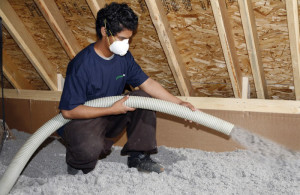UPGRADING ORIGINAL INSULATION TO SAVE ON YOUR HEATING BILLS
Homes built in the 1970s and 80s and insulated to the standards of their time (R‑12 versus today’s R‑41) are energy-hungry beasts. Weak insulation points in houses from that era include the roof (attic), which is responsible for numerous uncontrolled air leaks causing significant heat loss.
However, the R‑value of the attic in this type of home can be increased for a relatively modest investment, thereby cutting heating costs by as much as 20% to 30%. This can translate into thousands of dollars in energy savings over the lifetime of a house!
BLOWN-IN CELLULOSE: SUPERIOR-QUALITY THERMAL AND ACOUSTIC INSULATION
The material of choice for reinforcing roof insulation is indisputably blown-in cellulose. Made from ground-up paper, cellulose is renowned for its double efficiency when blown in to a density of 1.45 lbs. per cubic foot, both preventing hot air leaks and retaining radiant heat. Its high thermal capacity also helps enhance comfort in the summer by limiting daytime overheating. What’s more, cellulose is highly resistant to fire, vermin, humidity and mildew and has excellent soundproofing properties.
Isolation Majeau: your experts in isolation du sous-sol for the past 25 years
Visit the following pages to learn more about the services covered in this article:

Compared to other traditional insulation materials available on the market, such as mineral wool and fibreglass, cellulose yields better thermal performance per unit of thickness with its R‑value of 3.7 per inch. Offering superior performance over wool batt insulation because it is monolithic – meaning that it has no joints, since it is blown in – cellulose retains its insulating properties all year round, unlike fibreglass, which is less efficient in the winter.
To achieve an optimal air seal in your attic, it is also recommended to install a vapour barrier and seal all joints with urethane, including plumbing vents, attic hatches and all places where masonry walls come into contact with interior framing.
OLD INSULATION: REMOVE OR LEAVE IN PLACE?
In most cases, your roof’s original insulation is still effective according to the standards of its time. The idea is not to tear out your home’s insulation and replace it entirely but rather to blow in a second layer of insulation while taking care not to crush or move the older layer or block any soffits, which can create other problems.
WHAT SHOULD I DO IF MY ATTIC CONTAINS VERMICULITE?
In Canada in the 1970s and 80s, many attics were insulated using vermiculite contaminated with asbestos, which has been proved harmful to respiratory health if inhaled. It is consequently very important not to move or disturb vermiculite insulation but to get it tested first to find out whether it contains asbestos fibres. However, there is no need to panic: vermiculite does not pose any significant risk if it is left in place and effectively sealed. Simply keep in mind that you should never handle this type of insulation directly. If tests show that your vermiculite is not contaminated, then you can arrange for an insulation expert to proceed safely with adding a layer of cellulose on top of the original insulation.
WHEN IS THE BEST TIME TO INSTALL CELLULOSE INSULATION IN MY ATTIC?
Cellulose should ideally be installed in your attic in the spring, around March or April, to get your house ready for the coming season. Doing it at this time of the year also means that you won’t have to wait to get a quote and may even be able to proceed with the work the same week, unlike in the fall, when insulators are often very busy handling last-minute insulation projects.
CAN I INSTALL BLOWN-IN CELLULOSE MYSELF?
Blowing in cellulose is a complex task that you are better off leaving to certified professionals working with specialized equipment. Rental equipment (cellulose blowers) does not offer the same uniform output and consequently makes it more difficult to achieve optimal results. By using the services of experts, you are also ensuring that the insulation is blown into your attic at the right density, thereby eliminating any risk of settling.
This article was originally published on August 31, 2017 by Pierre Boucher





